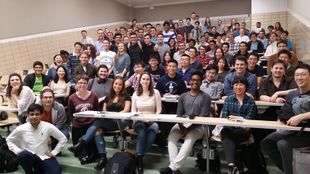1617-257/Homework Assignment 2: Difference between revisions
(→Doing) |
No edit summary |
||
| Line 1: | Line 1: | ||
{{1617-257/Navigation}} |
{{1617-257/Navigation}} |
||
{{In Preparation}} |
|||
==Reading== |
==Reading== |
||
Read, reread and rereread your notes to this point, and make sure that you really, really really, really really really understand everything in them. Do the same every week! Also, read, reread and rereread 3-4 of Munkres' book to the same standard of understanding. Remember that reading math isn't like reading a novel! If you read a novel and miss a few details most likely you'll still understand the novel. But if you miss a few details in a math text, often you'll miss everything that follows. So reading math takes reading and rereading and rerereading and a lot of thought about what you've read. Also, preread sections 5 and 6, just to get a feel for the future. |
Read, reread and rereread your notes to this point, and make sure that you really, really really, really really really understand everything in them. Do the same every week! Also, read, reread and rereread 3-4 of Munkres' book to the same standard of understanding. Remember that reading math isn't like reading a novel! If you read a novel and miss a few details most likely you'll still understand the novel. But if you miss a few details in a math text, often you'll miss everything that follows. So reading math takes reading and rereading and rerereading and a lot of thought about what you've read. Also, preread sections 5 and 6, just to get a feel for the future. |
||
| Line 14: | Line 13: | ||
'''Problem D.''' The ''Cantor set'' <math>C</math> is the set formed from the closed unit interval <math>[0,1]</math> by removing its open middle third <math>(\frac13,\frac23)</math>, then removing the open middle thirds of the remaining two pieces (namely then removing <math>(\frac19,\frac29)</math> and <math>(\frac79,\frac89)</math>), then removing the open middle thirds of the remaining 4 pieces, and so on. Prove that <math>C</math> is uncountable, compact and totally disconnected (the last property means "the only non-empty connected subsets of <math>C</math> are single points"). |
'''Problem D.''' The ''Cantor set'' <math>C</math> is the set formed from the closed unit interval <math>[0,1]</math> by removing its open middle third <math>(\frac13,\frac23)</math>, then removing the open middle thirds of the remaining two pieces (namely then removing <math>(\frac19,\frac29)</math> and <math>(\frac79,\frac89)</math>), then removing the open middle thirds of the remaining 4 pieces, and so on. Prove that <math>C</math> is uncountable, compact and totally disconnected (the last property means "the only non-empty connected subsets of <math>C</math> are single points"). |
||
'''Also,''' Add your name to the [[1617-257/Class Photo|Class Photo]] page! |
|||
==Submission== |
==Submission== |
||
Revision as of 08:15, 1 October 2016
Reading
Read, reread and rereread your notes to this point, and make sure that you really, really really, really really really understand everything in them. Do the same every week! Also, read, reread and rereread 3-4 of Munkres' book to the same standard of understanding. Remember that reading math isn't like reading a novel! If you read a novel and miss a few details most likely you'll still understand the novel. But if you miss a few details in a math text, often you'll miss everything that follows. So reading math takes reading and rereading and rerereading and a lot of thought about what you've read. Also, preread sections 5 and 6, just to get a feel for the future.
Doing
Solve problems 1ab, 2, 3, 4ab in section 4, but submit only the underlined problems/parts. In addition, solve the following problems, though submit only your solutions of problems A and B:
Problem A. Let be a metric space. Prove that the metric itself, regarded as a function , is continuous.
Problem B. Let be a subset of a metric space . Show that the distance function to , defined by , is a continuous function and that iff .
Problem C. Prove the "Lebesgue number lemma": If is an open cover of a compact space , then there exists an (called "the Lebesgue number of , such that every open ball of radius in is contained in one of the 's.
Problem D. The Cantor set is the set formed from the closed unit interval by removing its open middle third , then removing the open middle thirds of the remaining two pieces (namely then removing and ), then removing the open middle thirds of the remaining 4 pieces, and so on. Prove that is uncountable, compact and totally disconnected (the last property means "the only non-empty connected subsets of are single points").
Also, Add your name to the Class Photo page!
Submission
Here and everywhere, neatness counts!! You may be brilliant and you may mean just the right things, but if the teaching assistants will be having hard time deciphering your work they will give up and assume it is wrong.
This assignment is due in class on Friday October 7 by 2:10PM.















![{\displaystyle [0,1]}](https://wikimedia.org/api/rest_v1/media/math/render/svg/738f7d23bb2d9642bab520020873cccbef49768d)


